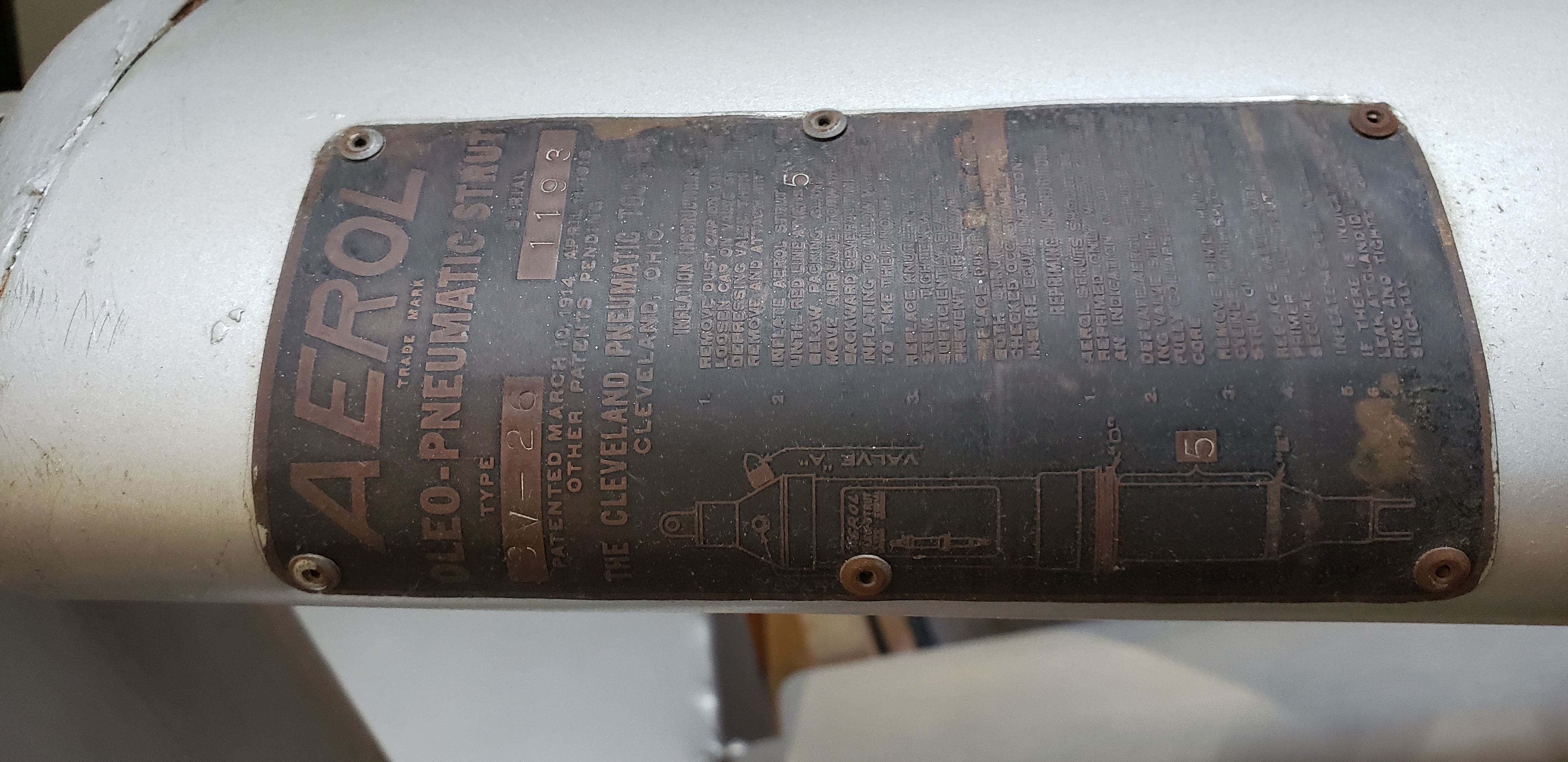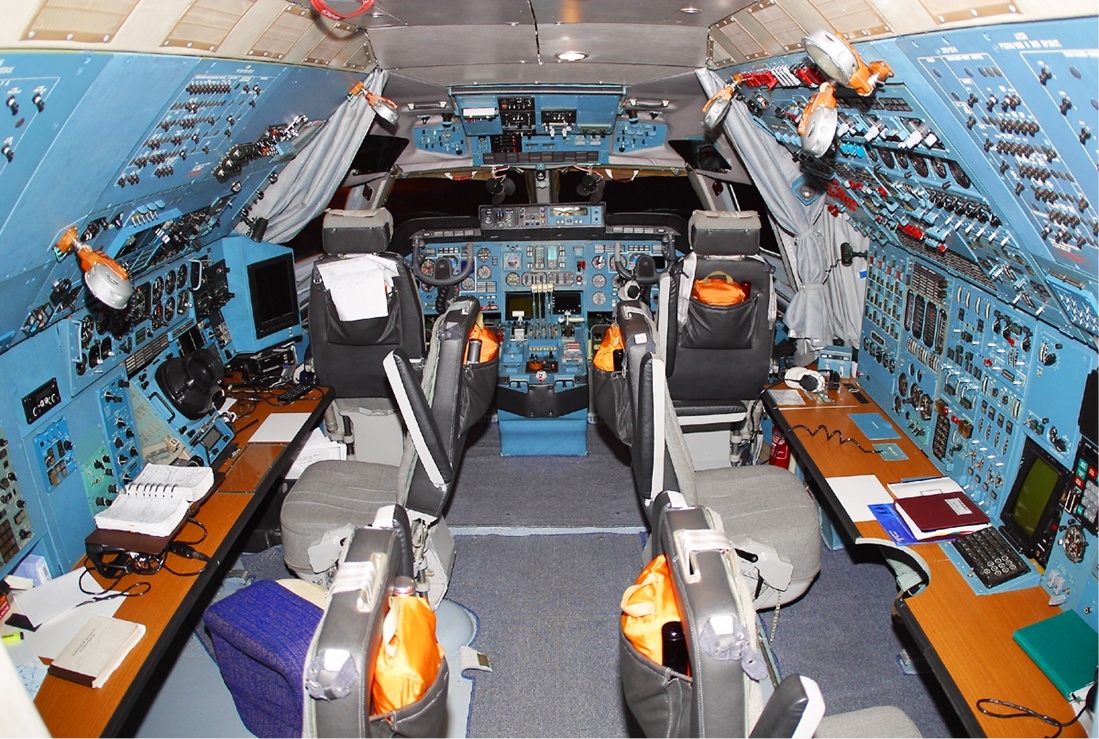|
Oleo Strut
An oleo strut is a pneumatic air–oil hydraulic shock absorber used on the landing gear of most large aircraft and many smaller ones. This design cushions the impacts of landing and damps out vertical oscillations. It is undesirable for an airplane to bounce on landing as it could lead to a loss of control, and the landing gear should not add to this tendency. A steel coil spring stores impact energy from landing and then releases it, while an oleo strut instead absorbs this energy, reducing bounce. As the strut compresses, the spring rate increases dramatically because the air is being compressed. The viscosity of the oil dampens the rebound movement. History and applications The original design for the oleo-pneumatic shock-absorbing strut was patented by British manufacturing conglomerate Vickers Armstrong during 1915. It had been derived from the recuperative gear design of the Vickers gun, controlling recoil by forcing oil through precisely sized orifices. Vickers' oleo stru ... [...More Info...] [...Related Items...] OR: [Wikipedia] [Google] [Baidu] |
Pneumatic
Pneumatics (from Greek ‘wind, breath’) is a branch of engineering that makes use of gas or pressurized air. Pneumatic systems used in Industrial sector, industry are commonly powered by compressed air or compressed inert gases. A centrally located and electrically-powered Gas compressor, compressor powers Pneumatic cylinder, cylinders, air motors, pneumatic actuators, and other pneumatic devices. A pneumatic system controlled through manual or automatic solenoid valves is selected when it provides a lower cost, more flexible, or safer alternative to electric motors, and hydraulic actuators. Pneumatics also has applications in dentistry, construction, mining, and other areas. Gases used in pneumatic systems Pneumatic systems in fixed installations, such as factories, use compressed air because a sustainable supply can be made by compressing Atmosphere of Earth, atmospheric air. The air usually has moisture removed, and a small quantity of oil is added at the compressor ... [...More Info...] [...Related Items...] OR: [Wikipedia] [Google] [Baidu] |
France
France (), officially the French Republic ( ), is a country primarily located in Western Europe. It also comprises of Overseas France, overseas regions and territories in the Americas and the Atlantic Ocean, Atlantic, Pacific Ocean, Pacific and Indian Oceans. Its Metropolitan France, metropolitan area extends from the Rhine to the Atlantic Ocean and from the Mediterranean Sea to the English Channel and the North Sea; overseas territories include French Guiana in South America, Saint Pierre and Miquelon in the North Atlantic, the French West Indies, and many islands in Oceania and the Indian Ocean. Due to its several coastal territories, France has the largest exclusive economic zone in the world. France borders Belgium, Luxembourg, Germany, Switzerland, Monaco, Italy, Andorra, and Spain in continental Europe, as well as the Kingdom of the Netherlands, Netherlands, Suriname, and Brazil in the Americas via its overseas territories in French Guiana and Saint Martin (island), ... [...More Info...] [...Related Items...] OR: [Wikipedia] [Google] [Baidu] |
Piston
A piston is a component of reciprocating engines, reciprocating pumps, gas compressors, hydraulic cylinders and pneumatic cylinders, among other similar mechanisms. It is the moving component that is contained by a cylinder and is made gas-tight by piston rings. In an engine, its purpose is to transfer force from expanding gas in the cylinder to the crankshaft via a piston rod and/or connecting rod. In a pump, the function is reversed and force is transferred from the crankshaft to the piston for the purpose of compressing or ejecting the fluid in the cylinder. In some engines, the piston also acts as a valve by covering and uncovering ports in the cylinder. __TOC__ Piston engines Internal combustion engines An internal combustion engine is acted upon by the pressure of the expanding combustion gases in the combustion chamber space at the top of the cylinder. This force then acts downwards through the connecting rod and onto the crankshaft. The connecting rod is att ... [...More Info...] [...Related Items...] OR: [Wikipedia] [Google] [Baidu] |
Антонов Ан-124 19530501006, Киев - Антонов (Гостомель) RP3349
Antonov, or Antonov Aeronautical Scientist/Technical Complex (Antonov ASTC) is a Ukrainian aircraft manufacturing and services company. Antonov may also refer to: * Antonov (surname) * Antonov Airlines, a Ukrainian cargo airline, division of the Antonov ASTC * Antonov Airport Antonov Airport ( uk, аеропорт «Антонов» ), also known as Hostomel (or Gostomel) Airport ( uk, аеропорт «Гостомель»), is an international cargo airport and testing facility in Ukraine, located near Hostomel, wh ..., or Hostomel Airport, a Ukrainian airport, operated by the Antonov ASTC * Antonovka, an apple cultivar {{disambiguation ... [...More Info...] [...Related Items...] OR: [Wikipedia] [Google] [Baidu] |
Motor Scooter
A scooter (motor scooter) is a motorcycle with an underbone or step-through frame, a seat, and a platform for the rider's feet, emphasizing comfort and fuel economy. Elements of scooter design were present in some of the earliest motorcycles, and motor scooters have been made since at least 1914. The global popularity of motor scooters dates from the post-World War II introductions of the Vespa and Lambretta models in Italy. These scooters were intended to provide economical personal transportation (engines from ). The original layout is still widely used in this application. Maxi-scooters, with larger engines from have been developed for Western markets. Scooters are popular for personal transportation partly due to being more affordable, easier to operate, and more convenient to park and store than a car. Licensing requirements for scooters are easier and cheaper than for cars in most parts of the world, and insurance is usually cheaper. The term motor scooter is sometime ... [...More Info...] [...Related Items...] OR: [Wikipedia] [Google] [Baidu] |
Taxiing
Taxiing (rarely spelled taxying) is the movement of an aircraft on the ground, under its own power, in contrast to towing or pushback where the aircraft is moved by a tug. The aircraft usually moves on wheels, but the term also includes aircraft with skis or floats (for water-based travel). An airplane uses taxiways to taxi from one place on an airport to another; for example, when moving from a hangar to the runway. The term "taxiing" is not used for the accelerating run along a runway prior to takeoff, or the decelerating run immediately after landing, which are called the takeoff roll and landing rollout, respectively. Etymology As early as 1909 aviation journalists envisioned aeroplanes to replace the taxicab in traffic-congested cities. Some aviators and some linguists report that around the year 1911 the slang word "taxi" was in use for an "airplane". They suggest that the way aircraft move under power before they take off or after they land reminded someone of ... [...More Info...] [...Related Items...] OR: [Wikipedia] [Google] [Baidu] |
Airframe
The mechanical structure of an aircraft is known as the airframe. This structure is typically considered to include the fuselage, undercarriage, empennage and wings, and excludes the propulsion system. Airframe design is a field of aerospace engineering that combines aerodynamics, materials technology and manufacturing methods with a focus on weight, strength and aerodynamic drag, as well as reliability and cost.Michael C. Y. Niu (1988). ''Airframe Structural Design''. Conmilit Press LTD. History Modern airframe history began in the United States when a 1903 wood biplane made by Orville and Wilbur Wright showed the potential of fixed-wing designs. In 1912 the Deperdussin Monocoque pioneered the light, strong and streamlined monocoque fuselage formed of thin plywood layers over a circular frame, achieving . First World War Many early developments were spurred by military needs during World War I. Well known aircraft from that era include the Dutch designer Anth ... [...More Info...] [...Related Items...] OR: [Wikipedia] [Google] [Baidu] |
Antonov An-124 Ruslan
The Antonov An-124 Ruslan (; russian: Антонов Ан-124 Руслан, , Ruslan; NATO reporting name: Condor) is a large, strategic airlift, four-engined aircraft that was designed in the 1980s by the Antonov design bureau in the Ukrainian SSR, then part of the Soviet Union (USSR). The An-124 is the world's 2nd heaviest gross weight production cargo airplane and heaviest operating cargo aircraft, behind the destroyed one-off Antonov An-225 Mriya (a greatly enlarged design based on the An-124) and the Boeing 747-8. The An-124 remains the largest military transport aircraft in service. In 1971, design work commenced on the project, which was initially referred to as ''Izdeliye 400'' (''Product #400''), at the Antonov Design Bureau in response to a shortage in heavy airlift capability within the Military Transport Aviation Command (''Komandovaniye voyenno-transportnoy aviatsii'' or VTA) arm of the Soviet Air Forces. Two separate final assembly lines plants setup for the ar ... [...More Info...] [...Related Items...] OR: [Wikipedia] [Google] [Baidu] |
Her Majesty's Stationery Office
The Office of Public Sector Information (OPSI) is the body responsible for the operation of His Majesty's Stationery Office (HMSO) and of other public information services of the United Kingdom. The OPSI is part of the National Archives of the United Kingdom and is responsible for Crown copyright. The OPSI announced on 21 June 2006 that it was merging with the National Archives. The merger took place in October 2006. The OPSI continues to discharge its roles and responsibilities from within the structure of the National Archives. Controller of HMSO and Director of OPSI The Controller of HMSO is also the Director of OPSI. HMSO continues to operate from within the expanded remit of OPSI. The Controller of HMSO also holds the offices of Kings's Printer of Acts of Parliament, King's Printer for Scotland and Government Printer for Northern Ireland. By virtue of holding these offices OPSI publishes, through HMSO, the ''London Gazette'', ''Edinburgh Gazette'', ''Belfast Gazette'' a ... [...More Info...] [...Related Items...] OR: [Wikipedia] [Google] [Baidu] |
Ministry Of Technology
The Ministry of Technology was a department of the government of the United Kingdom, sometimes abbreviated as "MinTech". The Ministry of Technology was established by the incoming government of Harold Wilson in October 1964 as part of Wilson's ambition to modernise the state for what he perceived to be the needs of the 1960s. The pledge was included in the Labour Party's 1964 general election manifesto: "A Labour Government will .. etup a Ministry of Technology to guide and stimulate a major national effort to bring advanced technology and new processes into the industry." History Foundation Wilson chose to appoint Frank Cousins, General Secretary of the Transport and General Workers Union, who had not previously sat in Parliament. Cousins had played a significant role in supporting Wilson's campaign to become leader of the Labour Party. C. P. Snow was created Baron Snow of Leicester so that he could play the role of parliamentary secretary in the House of Lords for the minist ... [...More Info...] [...Related Items...] OR: [Wikipedia] [Google] [Baidu] |
Hydraulic Fluid
A hydraulic fluid or hydraulic liquid is the medium by which power is transferred in hydraulic machinery. Common hydraulic fluids are based on mineral oil or water. Examples of equipment that might use hydraulic fluids are excavators and backhoes, hydraulic brakes, power steering systems, automatic transmissions, garbage trucks, aircraft flight control systems, lifts, and industrial machinery. Hydraulic systems like the ones mentioned above will work most efficiently if the hydraulic fluid used has zero compressibility. Functions and properties The primary function of a hydraulic fluid is to convey power. In use, however, there are other important functions of hydraulic fluid such as protection of the hydraulic machine components. The table below lists the major functions of a hydraulic fluid and the properties of a fluid that affect its ability to perform that function: Composition Base stock The original hydraulics fluid, dating back to the time of ancient Egypt ... [...More Info...] [...Related Items...] OR: [Wikipedia] [Google] [Baidu] |






